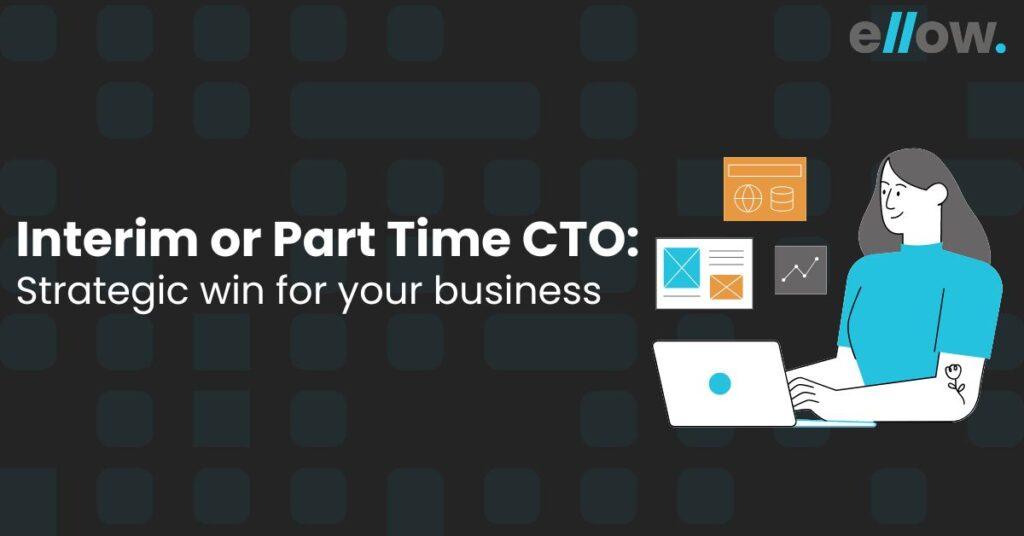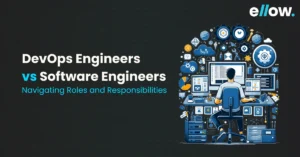
Blog
Interim or Part-Time CTO: Strategic win for your business
- Abhishek Ghosh
- July 11, 2023
- 2:41 pm

In this fast-paced, technology-driven era, a CTO or a Chief Technology Officer is one of the most crucial members of a business’s or organisation’s leadership team. Businesses, under the guidance of a CTO, leverage technology to drive innovation and growth and stay ahead of the curve. With their intervention, businesses gain a competitive advantage by identifying trends and emerging technologies and taking advantage of them for business growth.
But hiring a full-time CTO is costly!
According to the US Bureau of Labor and Statistics, the median annual salary for a CTO is $151,150.
In India, the range is somewhere between 60 lakhs to a crore.
For businesses undergoing transition or startups which are just in their initial day, hiring a full time CTO is not the best option. One simple solution for businesses is to have a part-time or interim CTO.
Table of Contents
Who is a part-time or an interim CTO?
An interim or part-time CTO is an individual with technical expertise who fills the void and serves as a solution in the absence of a permanent CTO. They have the same qualifications and technical know-how. Similar to a full-time CTO, a part-time CTO fosters innovation, develops strategy, oversees the product roadmap, and guides the team towards growth.
They may be visiting the office in person or offering to consult virtually. Since they are not working full-time, they do not receive all the benefits and bonus packages and may not be required to work 40 hours a week like a full-time employee.
Benefits of an Interim or a Part-time CTO
1. Cost Effectiveness
Hiring a part-time or interim CTO is much more cost-effective when compared to a full-time CTO. It is the perfect solution for startups, small-scale businesses, or even organisations that are undergoing transitions or are under a financial crunch.
Onboarding a new employee is always costly, and so is onboarding a new CTO. Employing a part-time CTO helps businesses save time and avoid the expenses of recruiting, onboarding, and training. They are available on an as-needed basis, so they generally charge for the number of hours put in or as agreed upon in the agreement.
This reduces the cost to the company, as they do not withdraw a full-time salary and do not receive any added benefits, equity, or bonus packages. This reduces the overall expenditure of the company and gives it more flexibility for budget allocation.
2. Guidance And Leadership
In the absence of a full-time leader, a part-time CTO guides everyone in the company regarding the technical aspects of the organisation. They give strategic directions regarding where the company should head and oversee the product roadmap.
They help set clear OKRs for the engineering team and help them achieve them. With their years of experience, they act as mentors or guides for everyone on the engineering team, helping them in their personal and professional development. They act as a bridge between the technical and non-technical teams, ensuring that everyone is on the same page.
3. Expertise and Experience
Interim or part-time CTOs bring with them years of technical expertise and experience working across various industries and organisations. With their industry acumen, they implement the best practices of the industry in your organisation. Part-time CTOs are more open to experiment and implement creative strategies and tactics to find solutions to problems. Organisations can tap into a diverse skill set and experience when they hire a part-time or interim CTO.
4. Scalability and Flexibility
Engaging with a part-time CTO gives businesses complete flexibility. They can be hired immediately without waiting for a notice period, which can vary from a month to three. They quickly become part of the team and start contributing, without requiring a lengthy onboarding process.
Depending upon business or project requirements, they can be available for a day in a month, a week, or daily. Moreover, it also gives businesses the flexibility to cancel the contract anytime, as required, during their period of engagement.
As we mentioned earlier, part-time or interim CTOs come with years of experience. They are used to handling rapid market changes and implementing solutions that will help the business grow even in the worst of times.
5. Objective Perspective and Innovation
The involvement of the part-time or interim CTO in day-to-day activities is minimal, and they have limited interaction with the executive team and the board members. Their views and opinions give a fresh outlook on organisation issues and problems, and they are unbiased and not influenced by anyone.
They can think outside the box and bring diverse experience across industries to the table, fostering a culture of innovation. Their nature of involvement with the organisation enables them to focus on strategic and technological growth rather than getting stuck in office politics and personal agendas in the workplace.
6. Bridge To a Full-Time CTO
The part-time or interim CTO serves as a bridge to a full-time CTO. They provide technical guidance, support, manage teams, and oversee the product roadmap during the company’s period of transition, growth, or restructuring. They fill in the shoes of a permanent CTO and assess technological needs, evaluate processes, and suggest improvements.
With their expertise, they can give suggestions and guide the organisation in hiring a full-time CTO. Also, having a part-time or interim CTO gives organisations the ability to gauge the effectiveness of the role and how it can support growth.
Difference between a full-time CTO and part-time CTO
The work of both the full-time CTO and part-time or interim CTO is the same, that is to give technical direction to the company. But there are certain aspects in which they differ:
| Full-Time CTO | Part-Time CTO | |
|---|---|---|
| Time Commitment | Works 40+ hours a week on a full-time basis. | Works usually less than 40+ hours a week |
| Availability | They are available full-time during regular working hours for calls and meetings | May not be available all the time and would be based on requirement or availability |
| Responsibility | Fully responsible for managing the technological functions and strategies in the organisation | Manages technology aspects on a part-time basis, may handle responsibility of multiple organisations at the same time |
| Decision-making | Actively involved and participates and influences the decision-making process in the organisation | Participates and gives suggestions in decision related to technology strategies |
| Team Management | Directly involved in managing the team, which involves hiring, performance development, and team management | Limited involvement in overall team management activities |
| Long-term planning | Responsible for long-term technology planning, setting goals, and aligning them with tech initiatives | May contribute to long-term planning, but involvement will be less. |
| Compensation | Considering the level of involvement and responsibility, the compensation package is quite higher | Compensation package is lower than a full time CTO and may be based on number of hours or per agreement |
| Engagement with board | Regularly engages with other board members in the organisation | May have limited engagement with the board members and the executive team |
Factors to consider before you hire a Permanent CTO?
Before you hire a full-time CTO, assess the organisation’s current landscape and evaluate its future growth plans and budget. Evaluate their cultural fit. Often, people come with years of experience and expertise, but they do not align with the organisation’s culture.
For people in leadership roles, their leadership style and values must align with those of the organisation. When everyone aligns with the culture, it ensures that the team is working like a well-oiled machine, and there is smooth communication, better cohesion, and seamless collaboration.
Hiring a full-time CTO is a long-term cost and commitment, so before you jump into a decision, make sure the person you are onboarding is the correct one, and for a more detailed guide on how to hire the Right CTO for your Startup read this blog.
Summing Up
In conclusion, whether you are hiring a part-time CTO or a full-time CTO, their primary goal will be the same, i.e., improving the technology landscape of the organisation. But the benefits of hiring a part-time or interim CTO can’t be overstated.
It is a cost-effective and strategic approach that empowers businesses to drive growth, enhance technical capabilities, and stay competitive while keeping their budget in check. Without any long-term commitment, organisations get to tap into the expertise of a CTO with diverse experience.
Sign up with ellow, and hire your next part-time or interim CTO in just 48 hours.
Frequently Asked Questions
Both full-time and part-time CTOs should have an extensive background in technology roles with at least 10–12 years of experience and the ability to develop strategies, manage teams, and drive innovation.
Along with technical expertise, a CTO must have the below skills:
- Strategic Vision
- Leadership and Management
- Business Acumen
- Problem-Solving and Decision-Making
- Communication Skills
- Adaptability and Learning
- Project Management
- Collaboration and Relationship Building
- Ethical and Responsible Conduct
The responsibilities of a Chief Technology Officer (CTO) can be summarized in the following five key points:
- Develop Technology Strategy: The CTO is responsible for developing and executing a comprehensive technology strategy aligned with the organization’s overall business goals.
- Technical Leadership: As the top technology executive, the CTO provides technical leadership and guidance to the organization.
- Team Management: The CTO manages and mentors the technical teams within the organization, including software engineers, data scientists, IT professionals, and other relevant personnel.
- Innovation and Research: They drive innovation by evaluating new technologies, assessing their potential impact on the organization, and recommending strategic investments in research and development to maintain a competitive edge.
- Stakeholder Engagement: The CTO plays a crucial role in engaging and collaborating with key stakeholders, both internally and externally.
The average salary of Chief Technology Officers (CTOs) can vary significantly around the world based on location, industry, and company size:
- United States: CTOs in the US can earn annual salaries ranging from $150,000 to $300,000
- Europe: CTO salaries in Europe vary across countries, they can earn average annual salaries ranging from €100,000 to €200,000 or more.
- Australia: CTO salaries earn average annual salaries ranging from AUD 150,000 to AUD 250,000 or more.
- India: CTOs in India can earn annual salaries ranging from INR 2,000,000 to INR 5,000,000 or more.







